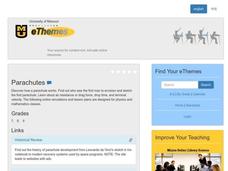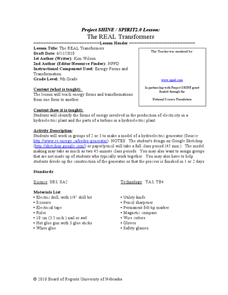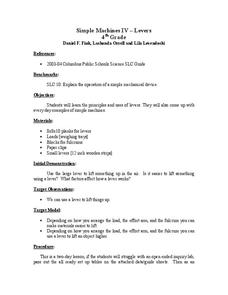Curated OER
Move It!
Students explore the notion that simple devices can help us move objects when an understanding of forces is applied. They apply the design process, make predictions, draw sketches, make a model and evaluate their solution.
Curated OER
Parachutes
Pupils examine how parachutes work, and research and discuss the first man to envision and sketch the first parachute. They analyze air resistance, drag force, drop time, and terminal velocity.
Curated OER
An Introduction to Simple Machines
Students investigate simple machines and their uses in everyday life. In this scientific method instructional activity, students examine physical tools such as wedges, screws, and levers using a "how does it work" approach. Students...
Curated OER
Alessandro Volta: The Invention of the Voltaic Pile (The First Electric Battery)
Students conduct a series of experiments on electricity. In this physics lesson, students study the work of Alessandro Volta particularly his experiment on the the Voltaic Pail. They build their own Voltaic Pile to recreate his experiment.
Curated OER
Don’t Sit Under the Apple Tree…You Might Become Famous
Students explore Newton's laws using CEENBoTs. In this physics lesson, students collect data and create tables and graphs. They calculate speed, acceleration and forces using mathematical formulas.
Curated OER
Magnets, Electromagnets, and Motors
Learners investigate the concepts of magnetism and its properties. They construct a magnet and test foods for iron content. Then students define the use of a motor and make their own electric motor while working in small groups. Then...
Curated OER
What is Matter?
Students create a definition of matter. In this physical science lesson, students work in pairs to sort items printed on cards into several categories (matter, non-matter, and unsure) and agree on a definition of matter.
Curated OER
The REAL Transformers
Ninth graders create a model of a hydroelectric generator. In this physics lesson, 9th graders discuss how energy can be transformed from one form to another. They make a flow chart for different energy generating plants.
Curated OER
Ionocraft Lifter
Students explore the different types of lifters through a series of activities. In this physics lesson, students explain the mechanics involved in the lifter designs. They compare aluminum versus zinc lifters.
Curated OER
When Earth Fails: How Earth?s Physical Changes Cause Natural Disasters
Students examine natural disasters and some safety measures that should be followed. In this natural disaster instructional activity students write a narrative, and research safety procedures.
Curated OER
Seeing Mathematics in the Forces of Nature
Students study waves and their characteristics. In this wave lesson students calculate the speed of waves, wavelength and the period.
Teach Engineering
Changing Fields
Eddy currents, Faraday's Law and Lenz's Law provide the connection between train brakes and and MRI machines in a lesson that asks teachers to provided the material needed so the pupils can understand the properties of changing magnetic...
Curated OER
FORCES, MOTION, AND ENERGY
Eighth graders engage in a variety of activities in order to investigate the basic concepts of physics. They read and answer questions in a written text. This is only one type of activity that is part of many others.
Curated OER
How Do Probes Get To Space
Students investigate how force works to propel rockets into outer space. In this physics lesson, students use a drinking straw, fishing line, a balloon, and tape to explore how force works in outer space. Students repeat the experiment...
Curated OER
How Do They Do That?
Third graders explore different careers by discussing which community helpers might be considered local heroes. In this career exploration lesson, 3rd graders work in small groups to discuss why certain people are considered...
Curated OER
Simple Machines - Levers
Fourth graders lift objects with the fulcrum and load in various positions and then experiment with how much force is exerted by the effort and load arms of the lever. They place 5 paper clips in the load and move the fulcrum to match...
Curated OER
Simple Machines
Fourth graders discover the principles and uses of gears noting that they can be used to change the direction of motion or the speed of an object. They may also change the force and/or distance through which an object turns. They then...
Urbana School District
Electric Fields
What kind of pears do electricians eat? Amperes! Presentation begins with electric field vectors for various charge configurations and field strengths for both point charges and uniform fields. It continues with various surfaces,...
Outdoor Learning Center
Outdoor Survival
Which of the following can you survive without for the longest time: water, food, or a positive mental attitude? The answer may surprise you. Guide learners of all ages through games, activities, and discussions about surviving in the...
Curated OER
Erupting Volcanoes!
Young scholars examine the causes of earthquakes, volcanoes, and floods, and explore how these events shape the surface of the earth. In this erupting volcanoes lesson, students create a volcano model of their own, make observations...
Curated OER
Fitness Notes - Weight Training
In this resource, the fitness notes cover the five principles of fitness, the principles of training/exercise, and cardio-respiratory fitness. The weight training notes cover the principles of weight training, proper techniques, and the...
CK-12 Foundation
Bow and Arrow
Where does the energy of an arrow come from? Is it from the person, the bow, or somewhere else? A simulation allows scholars to adjust the stretch distance and the elastic constant in order to understand where the energy comes from, what...
Cornell University
Buoyancy
Swimmers know to float by turning their bodies horizontally rather than vertically, but why does that make a difference? In an interesting lesson, scholars explore buoyancy and the properties of air and water. They test cups to see which...
Worchester Polytechnic Institute
Interactive Laboratory Activities for Secondary Education
Do you think the lab smells like rotten eggs? Sorry to hear about your sulfering. A set of five experiments covers many different topics including seasons, gravity, food, precipitation, and photosynthesis. Though not presented as a...

























